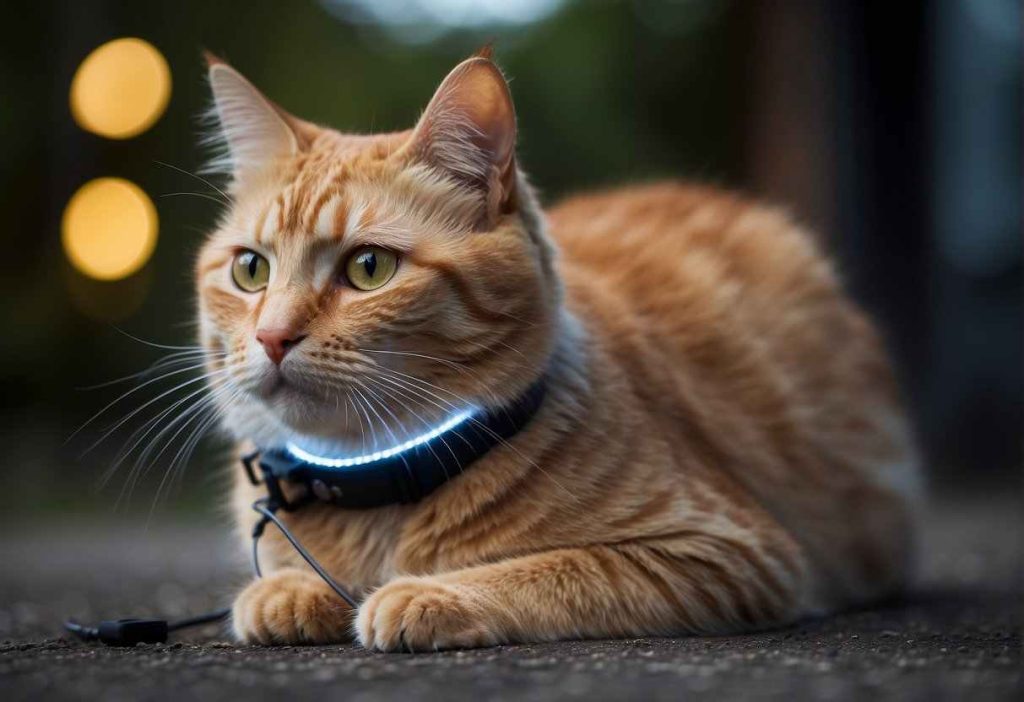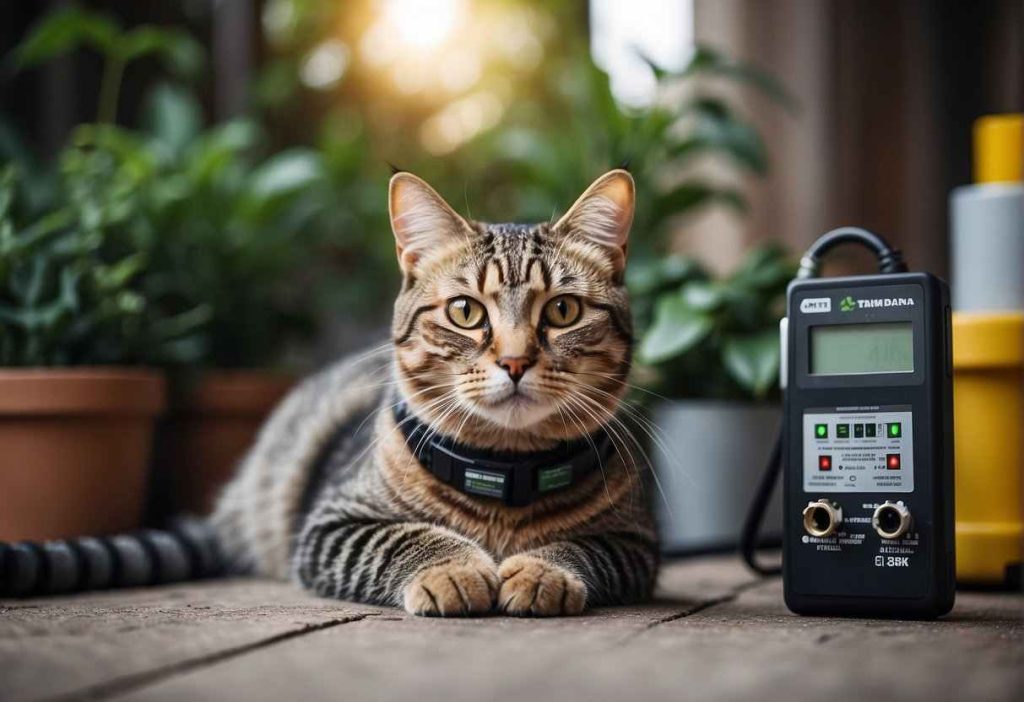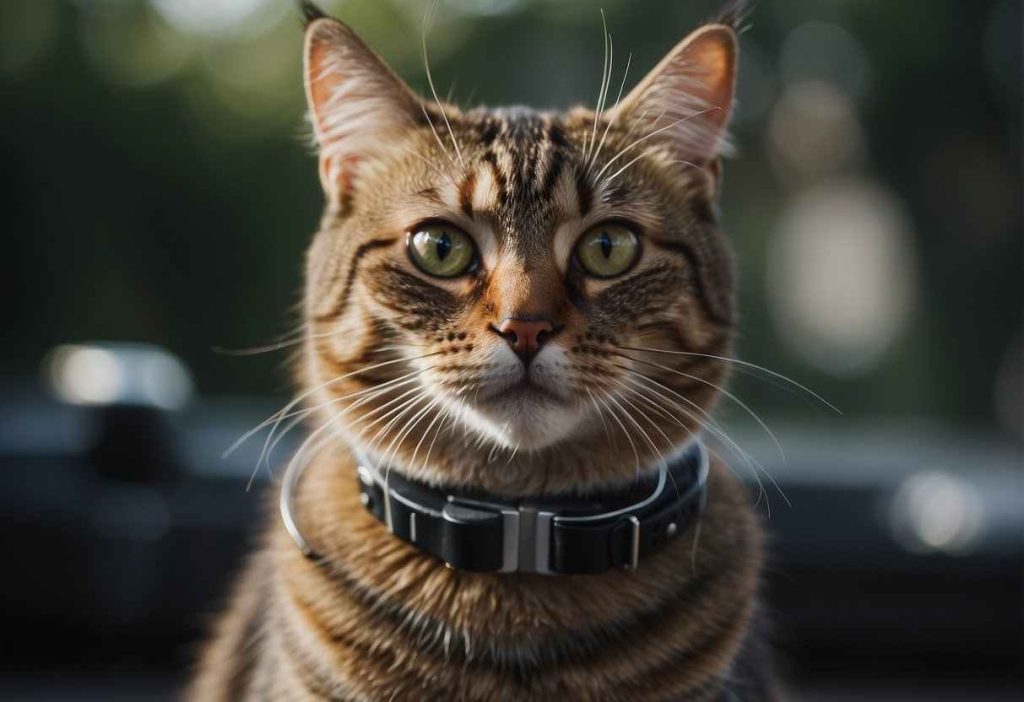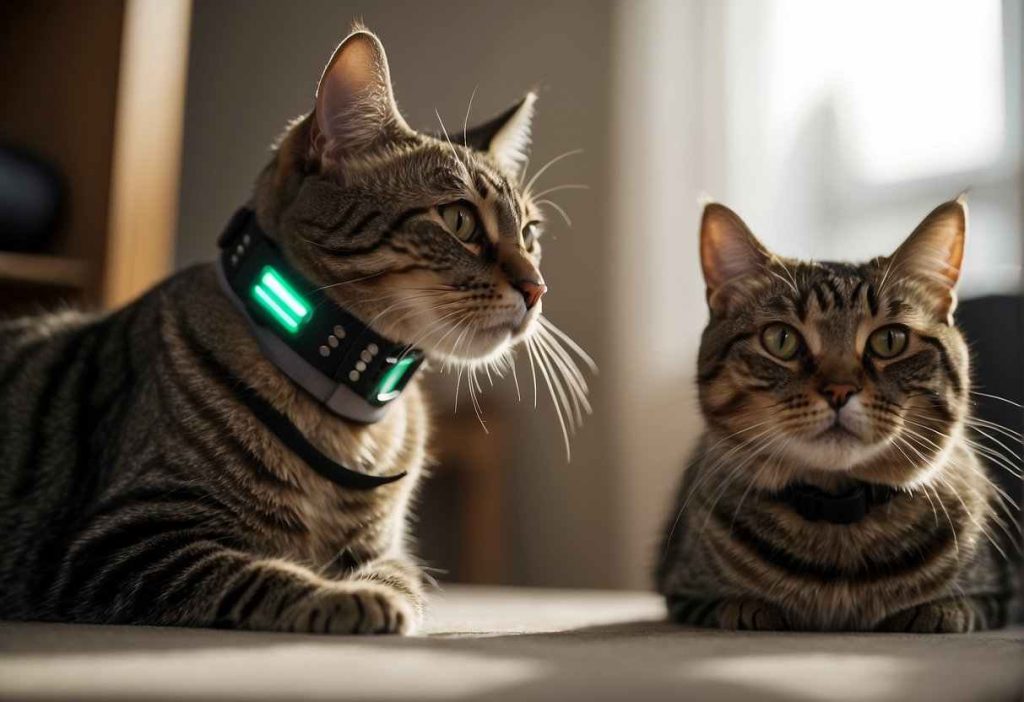Have you ever wondered do shock collars work on cats? Cats, unlike dogs, have a unique set of behaviors and responses.
Shock collars are most commonly associated with dog training, where they’re used to deter behavior like excessive barking or to maintain boundaries. (1)
For our feline counterparts, these devices can be adjusted to emit less intense stimuli, such as a vibration or a mild electric shock, in an attempt to guide behavior. (2)

Cats are known for their independence and particular nature, raising questions about the effectiveness of shock collars in altering their behavior.
The idea behind using a shock collar on a cat is to provide a sudden, unpleasant sensation that interrupts and discourages specific actions.
While the concept might seem straightforward, safety and ethical concerns come to the forefront of this discussion.
Is it really safe to use a tool designed to startle or cause discomfort to your cat, and does the outcome justify the means?
Key Takeaways
- Shock collars aim to modify cat behavior through stimuli like electric shocks or vibrations.
- Safety and ethical concerns are central when considering shock collars for cats.
- Alternatives to shock collars exist and should be evaluated for effectiveness and humanity.
Do Shock Collars Work on Cats: Evaluating the Effectiveness
Let’s sink our teeth into whether shock collars are the cat’s pajamas when it comes to behavior training, or if they’re just a hiss in the wind.
Shock Collars vs. Other Training Methods
- Positive Reinforcement: Arguably the cat’s meow, involves treats and praise, encouraging Fluffy to repeat good behavior. (3)
- Clicker Training: Click and treat—it’s like your cat hitting the jackpot at the Las Vegas of good manners. (4)
- Ultrasonic Devices: They emit a sound only your cat hears when they’re acting more like a wild lion than a house lion.
Long-term Outcomes of Using Shock Collars
- Short-term Shock: Initially, sure, Fluffy might be as jumpy as a cat on a hot tin roof, but…
- Long-term Lessons?: Reports suggest the hiss-worthy behavior might just sneak back, leaving you questioning if shock collars are a permanent fix or a mere pause button.
To get a claw on the situation, it’s important you know the volts and jolts:
- Voltage Range: Some collars pack a punch from 100 to 6,000 volts—yikes! Is Fluffy a cat or a light bulb? (5)
Let’s scratch the surface a bit more—will these voltage vests turn your cat into a purring picture of perfection, or just shake things up for a bit?
Remember, every cat is different; what works for Whiskers might just ruffle Midnight’s fur.
Paws and ponder before you decide on the shock collar route; alternative training might lead to happier, tail-flicking days…sans the shock.
Understanding the Safety Concerns

The Science Behind Shock Collars and Cat Safety
First off, scientific studies on shock collars and cats are like catnip treats in a dog park—nearly non-existent.
We’re scratching around for solid facts, but the evidence on how these collars affect your feline friend physically and psychologically is sparse.
- Lack of Studies: Little detailed research delves into the safety of shock collars on cats.
- Need for Expertise: Animal experts and veterinarians have not given a unanimous thumbs-up.
Expert Opinions on Shock Collars
Veterinarians and animal behaviorists aren’t all singing the same tune when it comes to shock collars.
Many pros are raising their eyebrows, concerned about the potential for negative effects on your furball’s well-being.
- Physical Impact: Could hidden health repercussions be simmering under that fur?
- Psychological Impact: What about your cat’s mood and mind? Could this method of training lead to a scaredy-cat or a fur-ious feline?
In short, when it comes to whether shock collars are the cat’s meow for training purposes, we’re left without a definitive yea or nay from the folks with the stethoscopes and the degrees.
It’s enough to make you purr-sue other methods of training, at least until the verdict is in.
Keep an ear to the ground for more research, and in the meantime, maybe let’s stick to treats and chin scratches for positive reinforcement, shall we?
Ethical Considerations of Using Shock Collars

Shock collars are quite a hot topic, and here’s why you might give this gadget a second thought.
Perspectives on Animal Welfare:
- Compassion vs. Correction: It’s hard not to wonder if it’s fair. Some say it’s like a tap on the shoulder, but others feel it’s more of a thump to the heart.
- Training vs. Trust: Can we build bonds with our pets if we’re also their shocker-in-chief?
Balancing Training Goals and Ethics:
- It’s all about finding that sweet spot where your cat’s behavior aligns with your household’s harmony without crossing an ethical line. (6)
Legal and Regulatory Considerations:
- Some regions say “No way!” to shock collars due to animal protection laws. That’s a pretty strong hint that we ought to ponder the implications, don’t you think? (7)
So, what do you believe? Is it a necessary tool for safety and training, or is it a step too far in our relationship with our pets?
Remember, laws can change, and so can public opinion. Keep an ear out for both; you never know what might be the talk of the town (or the cat café) next!
Exploring Alternatives to Shock Collars
When it comes to training your feline friend, the idea of using shock collars can make you wince. Why go the tough route when there are gentler methods?
Let’s meow-navigate through some kinder options:
Clicker Training
Have you tried clicker training? It’s like having a conversation with your cat using clicks. Simple yet effective, it relies on positive reinforcement. Each click marks a good behavior, followed by a treat. It’s a game of cause and ‘pawsitive’ effect!
Pros
- Builds a bond between you and your cat
- Non-intrusive and stress-free
Cons
- Requires patience and consistency
Harness Training
Ready for walkies? Cats can learn to walk on a harness! This method redirects their energy and satisfies their curiosity.
Pros
- Enriches your cat’s life with outdoor adventures
- Keeps them safe while exploring
Cons
- Some cats may never feel comfortable in a harness
Target Stick Training
Teach your cat to touch a target stick. This can lead to fun tricks or even practical behaviors, like coming when called.
Pros
- Mentally stimulating for your cat
- Can be incorporated into playtime
Cons
- Might take time for your cat to show interest
Success Stories?
Absolutely!
Many cat owners sing praises about clicker training transforming their kitty’s behavior. Picture this: a sassy cat turning into an obedient furball, all thanks to timed clicks and treats.
And those harness enthusiasts? They share incredible bonding moments on their feline-friendly strolls. How about that for a purr-suasive argument against old-school shock collars?
With these alternatives, you’re on your way to nurturing a loving and trusting relationship with your whiskered companion without a single zap!
Remember, every cat is a unique individual; what works for one may not work for another, so some trial and error might be on the cards.
Keep it upbeat, patient, and consistent, and you’ll likely find a method that you and your kitty both love.
Addressing General Weaknesses in Current Discussions

Key Points Often Overlooked:
- Effectiveness: Is there clear proof that shock collars work on cats, or are we stuck in a ‘maybe’ zone?
- Alternatives: Have we given the humble cat toy or clicker enough credit as behavior tools?
- Long-term effects: Are we considering how these gadgets might affect our furry pals down the road?
Now, if you’re a cat parent thinking, “Okay, but what do I do about Mr. Whiskers’ curtain-climbing adventures?”, here’s something actionable for you.
Starting with basic commands and rewarding good behavior can sometimes do wonders without causing a potential hissy fit (pun intended).
Pros and Cons in a Nutshell:
| Pros | Cons |
| Quick results | Potential harm |
| Remote training | Long-term fear |
Let’s not forget the impact on your relationship with your purr pal.
You want trust, not a kitty who’s scared of their own shadow.
Before you make any decisions, weigh the odds.
It’s not just about a quick fix; it’s about your cat’s overall well-being.
Remember, our feline friends aren’t just pets; they’re family.
So, let’s make sure our discussions about their behavior treatments are as full and nuanced as they deserve, alright? Keep it real and keep it kind!
Quick Recap
Shock collars, which can include various stimuli like electric shocks, beeps, vibrations, or spray, are devices primarily designed for behavior modification in animals.
Hefty debate surrounds their use, especially for cats, due to their controversial nature.
- Effectiveness: These collars may deter certain unwanted behaviors, which explains why some pet parents might consider their use. However, each cat’s response can vary broadly.
- Intensity: Collars often have adjustable settings for intensity, delivering shocks that can range from mild to powerful.
- Remember, your kitty’s well-being is crucial, so it’s vital to think about the implications of setting levels.
- Alternatives: Besides electronic collars, there are more humane training methods worth exploring, such as positive reinforcement, that do not involve aversive stimuli.
The use of shock collars on cats is a sensitive topic, and any decision should be made with careful consideration of the potential physical and emotional impacts.
Wondering how those little shocks feel?
We’ve gathered that the strength can be quite significant, reaching between 100 to 6,000 volts in some cases. Imagine that on your delicate skin!
- Safety: The safety of your pet should always be a top priority.
While some argue that properly used shock collars are safe, the risk of misuse or overuse can lead to stress or injury.
So you see, equipping your cat with a shock collar is not a decision to take lightly.
Always weigh your options, consider your cat’s unique personality and needs, and consult with a professional if needed.
Your kitty counts on you to make the best choices for their life – let’s ensure their trust is well-placed!
Frequently Asked Questions

When it comes to training your furry friend, you might have heard about shock collars. You’re not alone in wondering if they’re a safe and ethical choice for your cat.
Let’s tackle some common queries you might have!
Are shock collars an effective method to train cats?
Shock collars are a controversial training method. They work on the principle of aversion therapy, delivering a shock to discourage unwanted behavior.
But cats are quite different from dogs, and may not respond predictably to this kind of stimulus.
Some cats might become more fearful or stressed, which can lead to even more undesirable behaviors.
Can shock collars cause harm to my cat?
Yes, shock collars can potentially harm your cat. Depending on the device, the intensity of the shock can vary, and it must be used with caution.
There have been instances where shock collars caused burns, skin irritation, or anxiety in cats. Remember, your cat’s well-being should always be a top priority.
What are the ethical considerations for using shock collars on cats?
The use of shock collars raises ethical questions about animal welfare.
It involves punishing animals with pain or discomfort, which many believe should not be a part of any modern training program.
Critics argue that positive reinforcement is both kinder and more effective.
Are there any legal restrictions on using shock collars for cats?
This can depend on your region. Some places have laws in place that regulate or even ban the use of shock collars.
It’s important to check with local regulations to ensure you are not inadvertently breaking any laws.
What alternatives to shock collars are recommended for cat training?
Positive reinforcement is widely recommended for cat training. This involves rewarding your cat for good behavior instead of punishing bad behavior.
Think of treats, toys, or even affection as rewards.
Interactive play and clicker training are also effective alternatives to consider.
How do experts view the use of shock collars on cats?
Many animal behavior experts discourage the use of shock collars on cats.
They often suggest positive training methods and believe that understanding feline behavior is key to addressing issues, rather than resorting to punitive measures like shock collars.
Can shock collars affect the cat-owner relationship?
Absolutely. Your relationship with your cat could be damaged by the use of a shock collar.
Trust is an essential component of your bond, and using pain or fear to control behavior can undermine that trust, making your cat more wary or even afraid of you.
It’s always better to build a relationship based on mutual respect and understanding.


